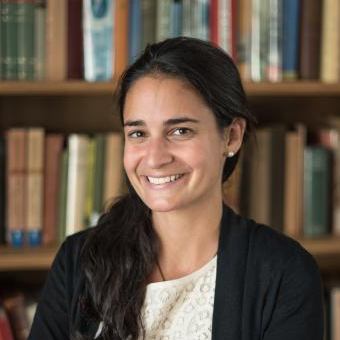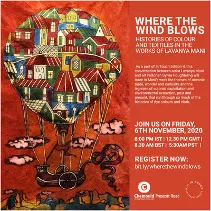Sylvia W. Houghteling

Contact
Department/Subdepartment
Areas of Focus
Early Modern Art | South Asian Art | Decorative Arts and Material Culture
Biography
Sylvia Houghteling specializes in early modern visual and material culture with a focus on the history of textiles, South Asian art and architecture, and the material legacies and ruptures of European colonialism.
Houghteling’s first book, The Art of Cloth in Mughal India (Princeton University Press, 2022) examined the textiles crafted and collected across the Mughal Empire in the sixteenth through eighteenth centuries, showing how woven objects helped to shape the social, political, religious, and aesthetic life of early modern South Asia. The book received a College Art Association Millard Meiss Publication Fund Grant and won the 2023 Charles Rufus Morey Book Award from the College Art Association. The Art of Cloth in Mughal India was also the recipient of the 2022 R.L. Shep Memorial Book Award from the Textile Society of America and the 2024 Bernard S. Cohn Book Prize from the Association for Asian Studies. Houghteling’s ongoing research is concerned with questions of dyes and temporality and the unique material histories of the Indian Ocean trade.
Houghteling was awarded the 2024 Christian R. and Mary F. Lindback Foundation Award for Distinguished Teaching from Bryn Mawr College. She completed her Ph.D. in the history of art from Yale University in 2015, where she received the Frances Blanshard Fellowship Fund Prize for her doctoral dissertation. She holds an A.B. in history and literature from Harvard University (2006), and an M.Phil. in history from the University of Cambridge (2007). Houghteling’s research has been supported by the National Endowment for the Humanities, the Metropolitan Museum of Art, the American Council of Learned Societies, the German Research Foundation (DFG), the Fulbright program, the Huntington Library, the Calouste Gulbenkian Museum, the Paul Mellon Centre for Studies in British Art, the Wolf Humanities Center at the University of Pennsylvania, the Yale University Art Gallery, and the Beinecke Scholarship Program.
Before entering the field of art history, Houghteling gained experience in weaving, textile dyeing, fashion design, felting, block-printing, and silk-painting. As someone who became interested in art through making it, Houghteling teaches and learns through conversations with contemporary practitioners and hands-on encounters with objects.
Teaching Interests
Sylvia Houghteling teaches undergraduate and graduate-level courses that study art objects in the context of the intercultural connections and conditions of exploitation of the early modern period, theories of ornament, the history of the textile medium and textile dyes; tapestry, and the visual arts and material culture of South Asia.
Teaching Interests
Sylvia Houghteling teaches undergraduate and graduate-level courses that study art objects in the context of the intercultural connections and conditions of exploitation of the early modern period; theories of ornament; the history of the textile medium; tapestry; and the visual arts and material culture of South Asia.
Selected Publications
*If it is not possible for you to access any of these publications in your library or online, please contact Sylvia Houghteling directly at shoughteli@brynmawr.edu.
- The Art of Cloth in Mughal India (Princeton: Princeton University Press, 2022). Recipient of the College Art Association Millard Meiss Publication Fund Grant, the Charles Rufus Morey Book Award from the College Art Association, and the R.L. Shep Memorial Book Award from the Textile Society of America.
- "Renaissance as Refreshment in the Mughal Empire: The Floral Carpets of Lahore and the Tarz-i Taza (Fresh Style) in Seventeenth-Century South Asia," in The Routledge Companion to Global Renaissance Art, eds. Stephen J. Campbell and Stephanie Porras (New York: Routledge, 2024), 346-362.
- "Histories of Silken Skills: Immigrant Sericulturalists in Early Modern South Asia" in Skilled Immigrants in the Textile and Fashion Industries: Stories from a Globe-Spanning History, ed. Nazanin Hedayat Munroe (London: Bloomsbury, 2024) 21-40.
- “Beyond Ice: Cooling through Cloth, Scent, and Hue in Eighteenth-Century South Asia” Journal18 16 (Fall 2023).
- “The Filaments of the Textile Trade: Subtle and Broad Trends in Exports from South Asia to Maritime Southeast Asia” Journal of Historians of Netherlandish Art (March/April 2023
- “Clothing the Book: Texts, Textiles, and an Ethics of Care” in Old Stacks, New Leaves: The Arts of the Book in South Asia, ed. Sonal Khullar (Seattle: University of Washington Press, 2023), 67-91. peer reviewed.
- “Wearing a Garden and Weaving Air: Fashion in the Mughal Empire” in India in Fashion, ed. Hamish Bowles (New York: Rizzoli, 2023), 40-51.
- “Kalamkari from the Coast: The Mughal Fame of Machilipatnam Cloth,” HALI 213 (Fall, 2022): 78-87.
- "Tapestry as Tainted Medium: Charles V’s Conquest of Tunis” in Purity and Contamination in Early Modern Art and Architecture, eds. Lauren Jacobi and Daniel Zolli (Amsterdam: Amsterdam University Press, 2021): 183-205.
- “Figurative Textiles,” in Indian Textiles: 1,000 Years of Art and Design, ed. Rosemary Crill. (Washington, D.C.: George Washington University Museum and The Textile Museum of Washington, D.C., 2021), 274-285.
- “Dyeing the Springtime: The Art and Poetry of Fleeting Textile Colors in Medieval and Early Modern South Asia” Religions 11 (2020): 1-20.
- “Origins in Entanglement: Connections Between English Crewel Embroidery and Indian Chintz” in Cloth that Changed the World: The Coloured Cottons of India, ed. Sarah Fee (New Haven: Yale University Press, 2020): 182-191.
- “‘From Scorching Spain and Freezing Muscovy’: English Embroidery and Early Modern Mediterranean Trade,” in The Mobility of People and Things in the Early Modern Mediterranean: The Art of Travel, ed. Elisabeth A. Fraser (London: Routledge, 2020): 9-26.
- Co-authored with Nobuko Shibayama, “Tools of the Master Dyer: Dye Materials in 17th and 18th Century South Asian Painted Cotton Textiles at the Metropolitan Museum of Art,” The Textile Museum Journal 46 (2019): 10-25.
- “Chintz in Seventeenth- and Eighteenth-Century Europe: Appliqué and the Bizarre” in Traded Treasures: Indian Textiles for Global Markets, ed. Ellen Avril (Ithaca: Johnson Museum of Art at Cornell University, 2019): 32-38.
- "The Tree of Life and the World of Wonder: ‘Ajā’ib Imagery on Seventeenth-Century Kalamkari” in Scent upon a Southern Breeze: The Synaesthetic Arts of the Deccan, ed. Kavita Singh (Mumbai: Marg Publications, 2018): 88-107.
- “The Emperor’s Humbler Clothes: Textures of Courtly Dress in Seventeenth-Century South Asia,” Ars Orientalis 47 (2017): 91-116.
- “Sentiment in Silk: Safavid Figural Textiles in Mughal Courtly Culture” in Affect, Emotion, and Subjectivity in the Art and Architecture of Early Modern Muslim Empires, ed. Kishwar Rizvi (Leiden: Brill, 2017): 124-147.
- “Kalamkari: The Richness of its Traditions,” ArtVarta, ed. Jasleen Dhamija (Summer, 2016): 130-135.
- “From Foot-cloth to Petticoat: The British Uses of Indian Chintz ca. 1700” in Setting the Scene: European Painted Cloths 1400 – 2000, ed. Christina Young and Nicola Costaras (London: Archetype Books, 2013): 51-57.
- “Another Perspective as Symbolic Form. Stella Kramrisch’s Writings on the Ajanta Paintings” 21: Inquiries into Art, History, and the Visual 4 (Fall 2024) 863-900. peer reviewed. Inquiries into Art, History, and the Visual
- “Stitching the Heavenly Spheres: Making Mughal and Deccani Tents” MARG 75 (2024): 52-61.
- “Mughal Textiles and Dress,” in The Great Mughals, ed. Susan Stronge (London: Victoria and Albert Museum, 2024), 233-246.
- “Lavanya Mani: Signs Taken for Wonders,” Gallery Chemould Prescott Road, Mumbai (2024).
Click here to view a YouTube video: "Conversation: Where the Wind Blows: Histories of Textiles and Colours in the Works of Lavanya Mani"
